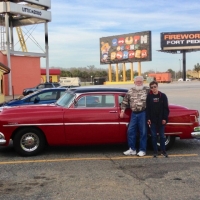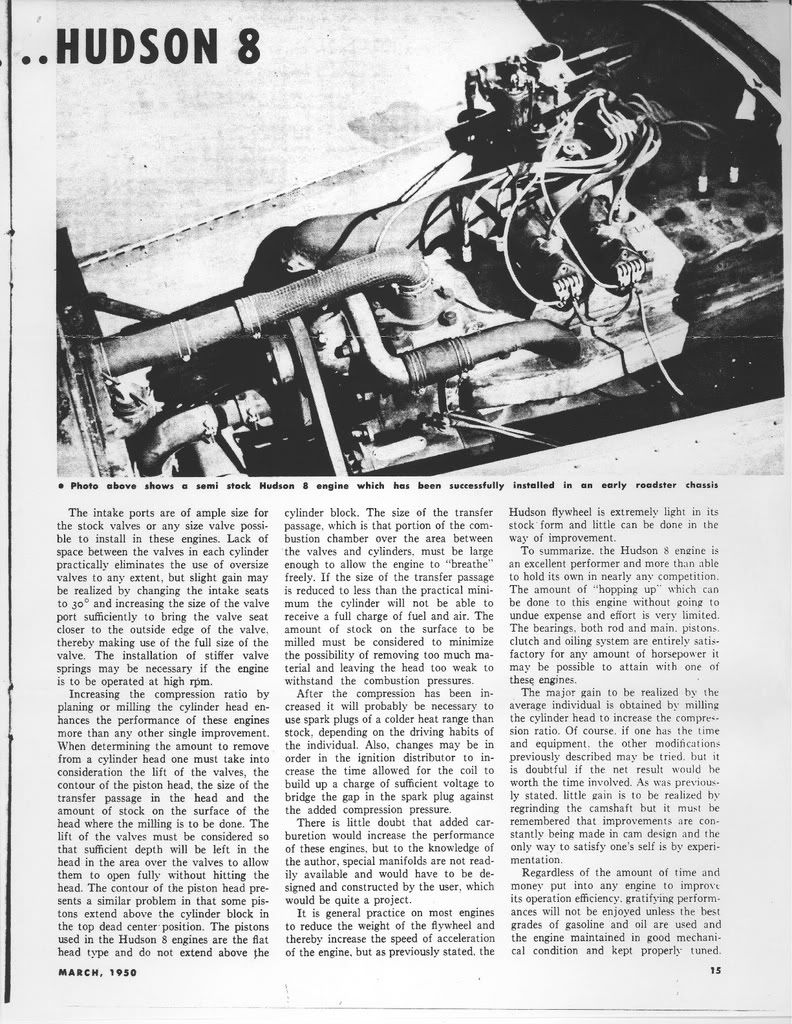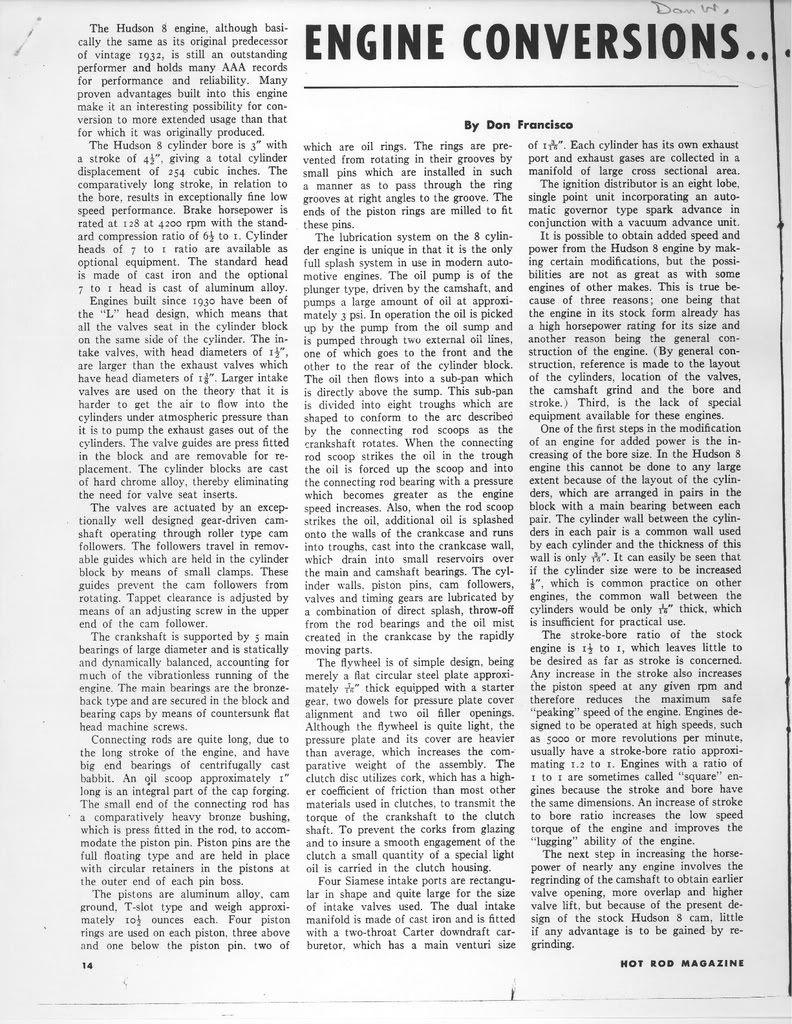Free flow 8cyl exhaust manifolds
There is mention in a recent thread about free flow exhaust manifolds produced by the by Pat MacDonald of the Railton Owners Club, presumably these were for the Hudson 8s.
I'm interested in seeing how they vary from the stock exhaust manifold, does anyone have a photo?
I'm interested in seeing how they vary from the stock exhaust manifold, does anyone have a photo?
0
Comments
-
I think Ivan has one on his Railton. I tried to get one off Pat but he's sold out and won't be making any more. I would buy one if it were available if anyone has one they'd let go!0
-
Here's a picture showing the MacDonald much larger section of the exhaust manifold and the spacer under the carb to keep its height as original without the exhaust heat area under the carb.
Ivan0 -
I SPOKE WITH PAT TODAY I THINK HE HAS MADE ANOTHER 6 MANAFOLDS SO IF YOU WANT ONE NOW WOULD BE THE TIME TO BUY IT0
-
Can some one tell me whats he doing with the oil lines on the bottom in the picture? Is he squirting oil directly at the rods or filling the troughs?0
-
For you guys who want more than just a nice cruiser, I expect one of these manifolds would produce a noticeable increase in the power. As some of you know, back in the fifties I had a split manifold on a pretty hot 8-cyl '38 sedan. It went on the engine during the build stage, so was there from day one when I put the engine in the car. The 3,300 lb. sedan with this legally stock engine turned 1/4 mile speeds in the low to mid-80's and about 17 sec. E.T. There came some situation where I needed to run a stock single manifold, and the first time out with it the reduction in power was easily noticeable. Suggests that when Hudson increased the manifold cross-section for '37, they should've gone a bit further with it.0
-
On a related matter on the 212's, can anyone tell me will a later '37-on exhaust manifold fit a '36 engine? Even if the manifold ports are bigger at the block interface that won't matter. The stud spacing will matter and how the inlet manifold fits in with it. Although making a new less restrictive inlet manifold wouldn't be hard, with water heating.
My '36 engine with 7.25:1 compression is horribly restricted by the stock manifold so I can either install some over the top 6 into 2 headers or see if a '37-on manifold can be made to fit. The Sydney Morning Herald tested a '36 sedan with the optional 7:1 head (100hp) and clocked 0-50 in 10 secs, 0-60 in 15 secs, 10-30 in top 6.4 secs, 10-30 in 2nd 4.0 secs. That is pretty quick, better than a stock '36 eight and just a bit slower than a Terraplane 8.0 -
-
here's another view of Ivan's engine with "high rise" exh. manifold, finned Edmunds alum. head; has full-pressure oil system and a magneto. It's in his Railton which he races in vintage events.0
-
Full Pressure oil system. Do you know if he drilled the crank? Or is he just feeding the main's
with the external piping that we see in the first photo? I see 8 tubes but only 5 mains. Mabye the other 3 are feeding the cam?0 -
you'll have to wait 'til Ivan comes back in here for him to give you a complete rundown on what all he's done; he sent me an e-mail explaining everything & with photos but that was several years ago & I didn't keep it - I remember it employs an oil pump from an English car.
Engine in a so-called Railton LST Replica that he bought in England then restored & updated.0 -
if you go to the Hudson 8 site at Google there is a complete set of photos of the engine inc. partially dis-assembled & some descriptive notes.
Here's a few things I gleaned: the Edmunds head "machined" providing 8-1 comp. ratio; special water jacket pipes extending thru block; 3" (std. bore") J. E. pistons with "deck height inc. by .040", piston, pin, and rings = 18% decrease in weight from original; special camshaft; "oil pump drive on camgear" & photo shows pipes into pan for all 8 rods; has an oil cooler; huge brakes off a Sunbeam; Jaguar flywheel - dynos at 165 h.p.!0 -
OK, this is not a full pressure oiling system. It relies on splash for everything--as original--but uses a real oil pump driven off the nose of the cam to pull out of the lower sump as original and pressure through a remote full flow oil filter and cooler and then back into the engine through the 3/16" tubes that pierce the oil sump and dipper tray at each rod trough. There is also a tube squirting in the timing gear area. Two things are accomplished. Because the car is a racing around corners, the oil surges away from the rod troughs so the rods can starve for oil. Squirting directly where the dippers on the rods are at bottom of the stroke provides some relief--when the car is racing, the oil temp is about 210 degrees on a hot day and the pressure at the rod squirters is only about 4 pounds. When cold, the system sees more like 10 pounds. The temperature of the oil is much, much higher without the oil cooler, and it could be argued that this is the real advantage to the system--filtered and cooler oil.
I have a drilled crank and set of beautiful aftermarket insert bearing rods to build a full pressure engine, but may never get there!
Hope that helps.
Ivan0 -
Ivan, Thank you very much for your description of what you've done, It makes good logic for how you drive your car. In your honest opinion, Is all of what you have done and spent worth the 35+ extra hp? Strickly power speaking, not because " I could, so I did" speaking.
Your last sentance has me going hmm....
Paul0 -
The extra horsepower is nice, of course, but the real benefit is reliability when used in a way that Hudson's engineers never intended the engine to be used. My engine was built to be streetable--3/4 race cam and a single carb as Railtons were built. More horsepower is available easily 220 I would think, but the engine would not do well on regular pump gas and it would look like a hot rod--not historic.
Hudson fostered raced an 8 cylinder car at Indy through Buddy Marr's car entered in 1931 and maybe 32. This was a pressure oiled engine. The splash oiled Terraplane 8 engined cars of 1933 and 1934 failed to finish as a result of con rod failure.
Ivan0
This discussion has been closed.
Categories
- 36.9K All Categories
- 112 Hudson 1916 - 1929
- 20 Upcoming Events
- 92 Essex Super 6
- 28.6K HUDSON
- 571 "How To" - Skills, mechanical and other wise
- 995 Street Rods
- 151 American Motors
- 178 The Flathead Forum
- 49 Manuals, etc,.
- 78 Hudson 8
- 44 FORUM - Instructions and Tips on using the forum
- 2.8K CLASSIFIEDS
- 608 Vehicles
- 2.1K Parts & Pieces
- 77 Literature & Memorabilia
- Hudson 1916 - 1929 Yahoo Groups Archived Photos




